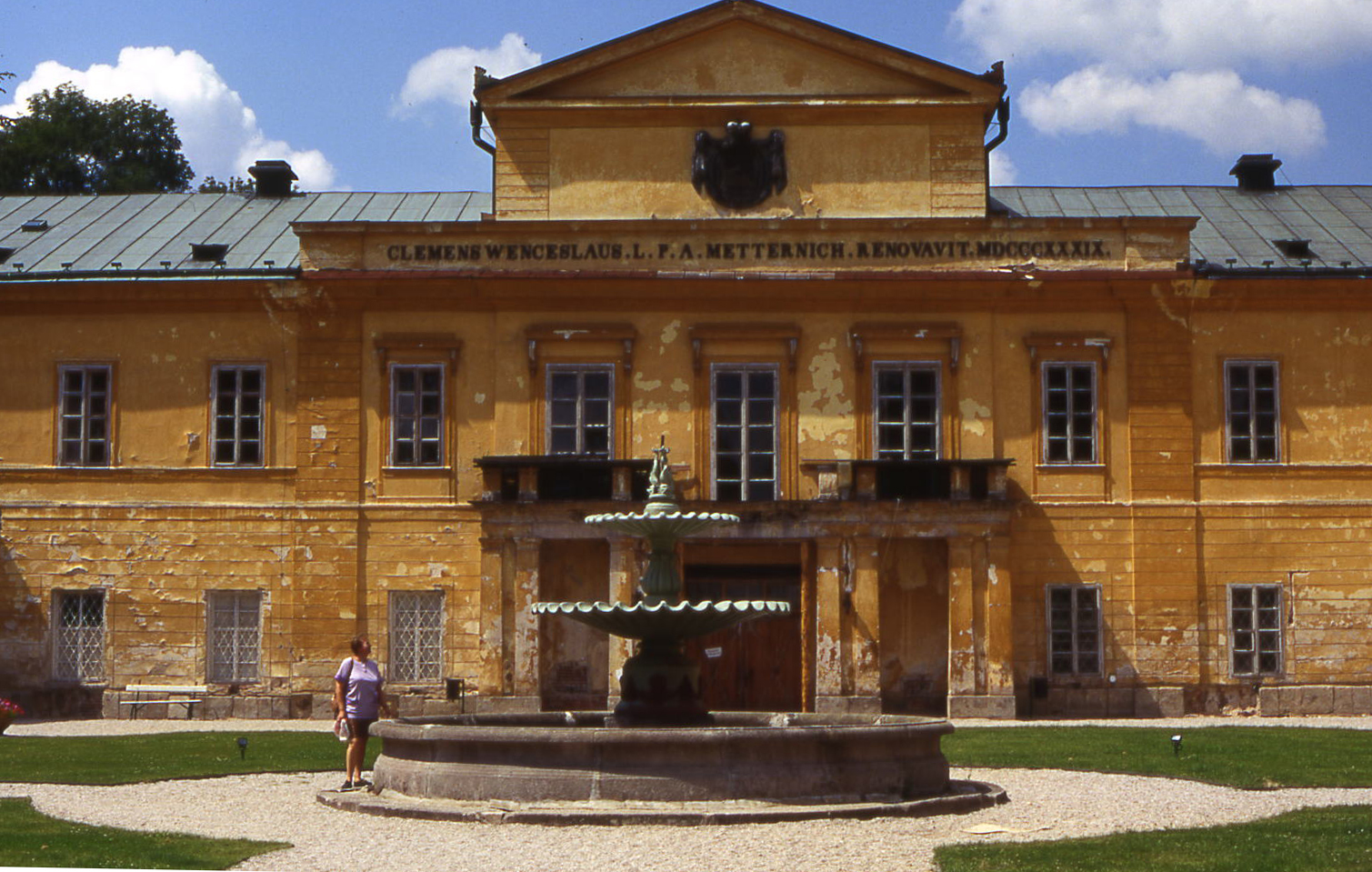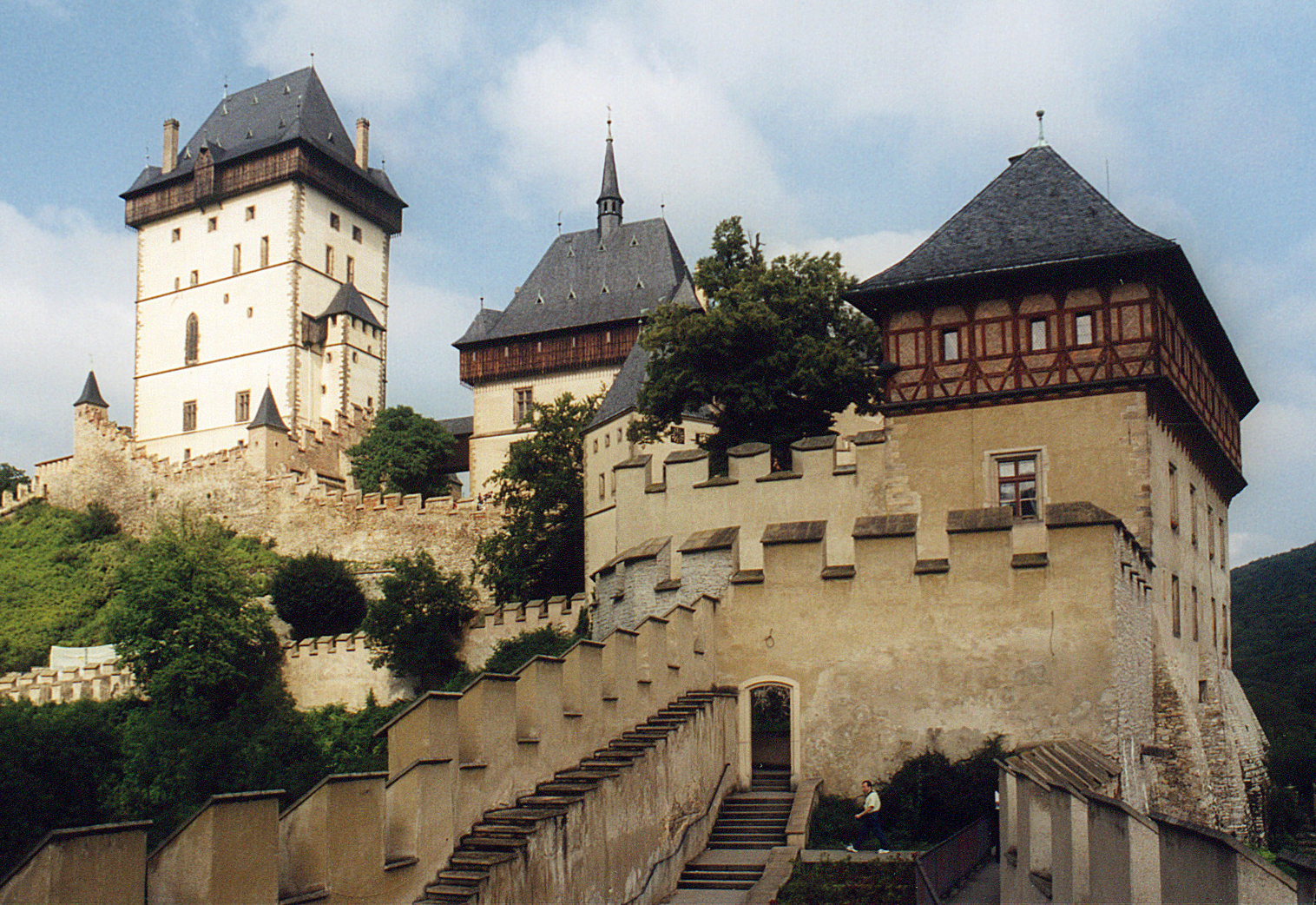|
Kynžvart Castle
Kynžvart Castle (German: Schloss Königswart) is a historic château located near Lázně Kynžvart in the Cheb District of the Czech Republic. The building's architecture is in the neoclassical style. After extensive renovations, the castle was reopened to the public in 2000. A guided tour takes visitors through 25 rooms of the castle. History The first Schloss Königswart, built before 1600, collapsed. After the Battle of White Mountain during the Thirty Years' War, the remains of the castle were confiscated and by 1630 granted to the Metternich family. From 1682 to 1691, Count Philipp Emmerich von Metternich (1621-1698) turned the decayed ruins into a Baroque residence. From 1821 to 1836, the Austrian Chancellor Klemens Wenzel von Metternich remodeled the building in the neoclassical style with the help of architect Pietro Nobile. The castle was confiscated from the Metternich family in 1945 by the Czechoslovak government. The castle has a library that includes over 200 e ... [...More Info...] [...Related Items...] OR: [Wikipedia] [Google] [Baidu] |
Austria
Austria, , bar, Östareich officially the Republic of Austria, is a country in the southern part of Central Europe, lying in the Eastern Alps. It is a federation of nine states, one of which is the capital, Vienna, the most populous city and state. A landlocked country, Austria is bordered by Germany to the northwest, the Czech Republic to the north, Slovakia to the northeast, Hungary to the east, Slovenia and Italy to the south, and Switzerland and Liechtenstein to the west. The country occupies an area of and has a population of 9 million. Austria emerged from the remnants of the Eastern and Hungarian March at the end of the first millennium. Originally a margraviate of Bavaria, it developed into a duchy of the Holy Roman Empire in 1156 and was later made an archduchy in 1453. In the 16th century, Vienna began serving as the empire's administrative capital and Austria thus became the heartland of the Habsburg monarchy. After the dissolution of the H ... [...More Info...] [...Related Items...] OR: [Wikipedia] [Google] [Baidu] |
Museums In The Karlovy Vary Region
A museum ( ; plural museums or, rarely, musea) is a building or institution that cares for and displays a collection of artifacts and other objects of artistic, cultural, historical, or scientific importance. Many public museums make these items available for public viewing through exhibits that may be permanent or temporary. The largest museums are located in major cities throughout the world, while thousands of local museums exist in smaller cities, towns, and rural areas. Museums have varying aims, ranging from the conservation and documentation of their collection, serving researchers and specialists, to catering to the general public. The goal of serving researchers is not only scientific, but intended to serve the general public. There are many types of museums, including art museums, natural history museums, science museums, war museums, and children's museums. According to the International Council of Museums (ICOM), there are more than 55,000 museums in 202 countr ... [...More Info...] [...Related Items...] OR: [Wikipedia] [Google] [Baidu] |
Castles In The Karlovy Vary Region
A castle is a type of fortified structure built during the Middle Ages predominantly by the nobility or royalty and by military orders. Scholars debate the scope of the word ''castle'', but usually consider it to be the private fortified residence of a lord or noble. This is distinct from a palace, which is not fortified; from a fortress, which was not always a residence for royalty or nobility; from a ''pleasance'' which was a walled-in residence for nobility, but not adequately fortified; and from a fortified settlement, which was a public defence – though there are many similarities among these types of construction. Use of the term has varied over time and has also been applied to structures such as hill forts and 19th-20th century homes built to resemble castles. Over the approximately 900 years when genuine castles were built, they took on a great many forms with many different features, although some, such as curtain walls, arrowslits, and portcullises, were ... [...More Info...] [...Related Items...] OR: [Wikipedia] [Google] [Baidu] |
List Of Castles In The Czech Republic ...
This is a list of castles and chateaux in the Czech Republic, organized by regions. Central Bohemia (S) Hradec Králové (H) Karlovy Vary (K) Liberec (L) Moravia-Silesia (T) Olomouc (M) Pardubice (E) Plzeň (P) Prague (A) South Bohemia (C) South Moravia (B) Ústí nad Labem (U) Vysočina (J) Zlín (Z) See also * List of castles in Europe * List of castles External links Czech Republic - Manors, Castles, Historical TownsHrady.cz {{Châteaux Czech Republic Castles A castle is a type of fortified structure built during the Middle Ages predominantly by the nobility or royalty and by military orders. Scholars debate the scope of the word ''castle'', but usually consider it to be the private fortified r ... [...More Info...] [...Related Items...] OR: [Wikipedia] [Google] [Baidu] |
Incunabula
In the history of printing, an incunable or incunabulum (plural incunables or incunabula, respectively), is a book, pamphlet, or broadside that was printed in the earliest stages of printing in Europe, up to the year 1500. Incunabula were produced before the printing press became widespread on the continent and are distinct from manuscripts, which are documents written by hand. Some authorities include block books from the same time period as incunabula, whereas others limit the term to works printed using movable type. there are about 30,000 distinct incunable editions known. The probable number of surviving individual copies is much higher, estimated at around 125,000 in Germany alone. Through statistical analysis, it is estimated that the number of lost editions is at least 20,000. Around 550,000 copies of around 27,500 different works have been preserved worldwide. Terminology Incunable is the anglicised form of ''incunabulum'', reconstructed singular of Latin ''in ... [...More Info...] [...Related Items...] OR: [Wikipedia] [Google] [Baidu] |
Czechoslovakia
, rue, Чеськословеньско, , yi, טשעכאסלאוואקיי, , common_name = Czechoslovakia , life_span = 1918–19391945–1992 , p1 = Austria-Hungary , image_p1 = , s1 = Czech Republic , flag_s1 = Flag of the Czech Republic.svg , s2 = Slovakia , flag_s2 = Flag of Slovakia.svg , image_flag = Flag of Czechoslovakia.svg , flag = Flag of Czechoslovakia , flag_type = Flag(1920–1992) , flag_border = Flag of Czechoslovakia , image_coat = Middle coat of arms of Czechoslovakia.svg , symbol_type = Middle coat of arms(1918–1938 and 1945–1961) , image_map = Czechoslovakia location map.svg , image_map_caption = Czechoslovakia during the interwar period and the Cold War , national_motto = , anthems = ... [...More Info...] [...Related Items...] OR: [Wikipedia] [Google] [Baidu] |
Pietro Nobile
Pietro Nobile was an Austro-Hungarian Neoclassicist architect and builder born in Campestro (Capriasca), Switzerland, 11 November 1774 – Vienna, Austria, 7 November 1854. He is regarded as one of the most prominent architects of the late classicism in Vienna, and the leading architect of the Habsburg court. 36202871 His father moved the family to Trieste where the young Pietro attended school. He continued to be educated in Rome by Antonio Canova between 1801 and 1806. In 1807 he was appointed engineer office for construction in charge of Trieste, Istria, Aquileia and Gorizia. In 1810 he was officially appointed chief engineer for construction of bridges and roads in the Illyrian coast in Istria. He designed the coastal road from Koper to Pula, made new plans, sketches and drawings of monuments such as the Pula Arena, the Temple of Augustus and the Arch of the Sergii. He also designed St. Peter's Church standing on Tartini Square in Piran, Slovenia and Sant'Antonio Taumat ... [...More Info...] [...Related Items...] OR: [Wikipedia] [Google] [Baidu] |
Klemens Wenzel Von Metternich
Klemens Wenzel Nepomuk Lothar, Prince of Metternich-Winneburg zu Beilstein ; german: Klemens Wenzel Nepomuk Lothar Fürst von Metternich-Winneburg zu Beilstein (15 May 1773 – 11 June 1859), known as Klemens von Metternich or Prince Metternich, was a conservative Austrian statesman and diplomat who was at the center of the European balance of power known as the Concert of Europe for three decades as the Austrian Empire's foreign minister from 1809 and Chancellor from 1821 until the liberal Revolutions of 1848 forced his resignation. Born into the House of Metternich in 1773 as the son of a diplomat, Metternich received a good education at the universities of Strasbourg and Mainz. Metternich rose through key diplomatic posts, including ambassadorial roles in the Kingdom of Saxony, the Kingdom of Prussia, and especially Napoleonic France. One of his first assignments as Foreign Minister was to engineer a détente with France that included the marriage of Napoleon to the Austr ... [...More Info...] [...Related Items...] OR: [Wikipedia] [Google] [Baidu] |
Baroque Architecture
Baroque architecture is a highly decorative and theatrical style which appeared in Italy in the early 17th century and gradually spread across Europe. It was originally introduced by the Catholic Church, particularly by the Jesuits, as a means to combat the Reformation and the Protestant church with a new architecture that inspired surprise and awe. It reached its peak in the High Baroque (1625–1675), when it was used in churches and palaces in Italy, Spain, Portugal, France, Bavaria and Austria. In the Late Baroque period (1675–1750), it reached as far as Russia and the Spanish and Portuguese colonies in Latin America. About 1730, an even more elaborately decorative variant called Rococo appeared and flourished in Central Europe. Baroque architects took the basic elements of Renaissance architecture, including domes and colonnades, and made them higher, grander, more decorated, and more dramatic. The interior effects were often achieved with the use of ''quadratura'', or ... [...More Info...] [...Related Items...] OR: [Wikipedia] [Google] [Baidu] |
Château
A château (; plural: châteaux) is a manor house or residence of the lord of the manor, or a fine country house of nobility or gentry, with or without fortifications, originally, and still most frequently, in French-speaking regions. Nowadays a ''château'' may be any stately residence built in a French style; the term is additionally often used for a winegrower's estate, especially in the Bordeaux region of France. Definition The word château is a French word that has entered the English language, where its meaning is more specific than it is in French. The French word ''château'' denotes buildings as diverse as a medieval fortress, a Renaissance palace and a fine 19th-century country house. Care should therefore be taken when translating the French word ''château'' into English, noting the nature of the building in question. Most French châteaux are "palaces" or fine "country houses" rather than "castles", and for these, the word "château" is appropriate in English. ... [...More Info...] [...Related Items...] OR: [Wikipedia] [Google] [Baidu] |
House Of Metternich
The House of Metternich is an old German noble family originating in the Rhineland. The most prominent member was Prince Klemens von Metternich, who was the dominant figure at the Congress of Vienna (1814–1815). As a former reigning house ( mediatised), the Metternich family belonged to the small circle of high nobility. History The family originated as a cadet branch of the lords of Hemmerich (which today is a district of Bornheim, near Bonn). The head of the family rose to the position of hereditary chamberlain of the Elector of Cologne. This branch of the family drew its name from the village of Metternich in Weilerswist, beginning in the 13th century. By the 16th century, the family had seven distinct branches: * Metternich-Burscheid * Metternich- Winneburg * Metternich-Chursdorf * a branch in Lorraine * Metternich-Müllenark in the Duchy of Jülich * Metternich-Brohl-Heddesdorf in the Duchy of Jülich Metternich-Burscheid Dieter von Metternich acquired Zievel by mar ... [...More Info...] [...Related Items...] OR: [Wikipedia] [Google] [Baidu] |








